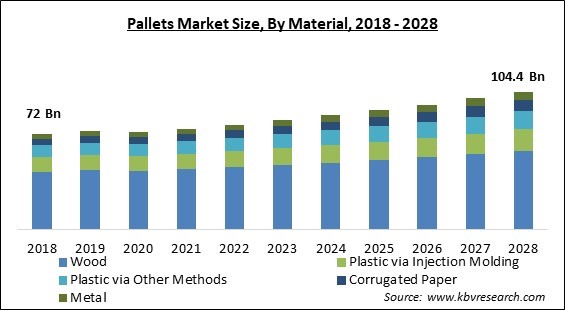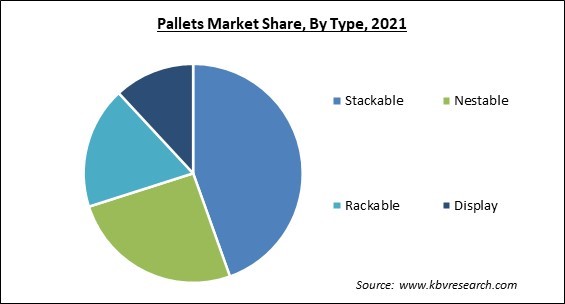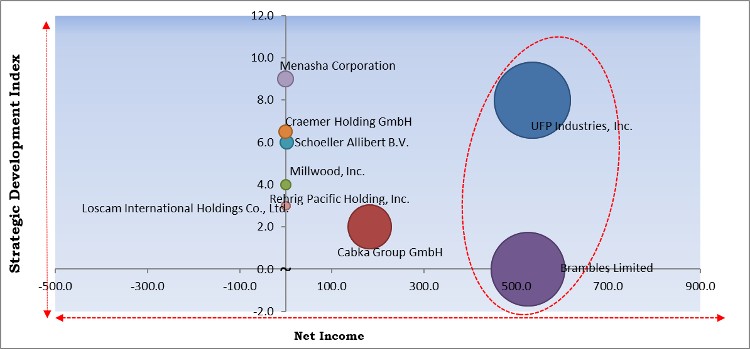The Global Pallets Market size is expected to reach $104.4 billion by 2028, rising at a market growth of 4.7% CAGR during the forecast period.
Pallets are a type of tertiary packaging that can be used in supply chains for stacking, storing, protecting, and transporting items. They serve as a foundation for the unitization of items in logistics and warehousing. Pallets can also be made from a variety of materials, including wood, plastic, metal, and corrugated paper, and they can be handled by forklifts, pallet jacks, and conveyors. They're used in almost every supply chain, including industries like chemicals, food and beverage, and retail.

Pallets, together with palletized handling, were one of the most important logistical techniques to develop in the twentieth century. Pallets first arose in the nineteenth century and have since evolved to aid in the creation of contemporary logistics. Pallets have become increasingly important in supply chain applications, providing for huge efficiency gains in the handling and transit of unit loads when compared to lose stacking of items. During World War 2, more refinements to pallet design and management were made. Pallet reuse, for example, has become more common in the supply chain, and pallet collars have been designed to allow for multiple stacking of sensitive items. During this period, the concept of pallet pooling became more widely addressed.
Pallets are divided into two types: block and stringer pallets. Pallet entry by material handling equipment is more flexible with block pallets. Solid stringers allow two-way entry (at either end of the pallet), notched stringers provide partial four-way entry (by forklifts through the notches, as well as complete access from the ends), and block pallets allow full four-way entry.
Construction, industrial, lodging, and tourism businesses were all severely impacted by the COVID-19 pandemic. Manufacturing operations have been interrupted or limited. On a global scale, construction and transportation activities, as well as their supply networks, were disrupted. This resulted in a decrease in pallet manufacture as well as demand in the market, limiting the sector's growth. On the other hand, industries are gradually resuming normal manufacturing and service operations. This is predicted to result in the re-starting of pallets market businesses at full capacity, assisting the market's recovery by the end of 2021. The rise of e-commerce websites during the pandemic is also expected to facilitate the growth of the pallets market in the upcoming years.
In recent decades, the global economy has risen at a breakneck pace. Part of this growth has been spurred by a faster-than-expected increase in international trade. Trade growth is the product of both technological breakthroughs and concerted efforts to remove trade barriers. Some developing nations have opened their economies to fully exploit trade opportunities, while the majority have not. Integration into the global economy has shown to be a significant tool for promoting economic growth, development, and poverty reduction for countries. World trade has grown at a rate of 6% per year on average over the last 20 years, twice as fast as global output.
The market is driven by the usage of pallets for transportation purposes. Firms that move bulk items as part of an integrated, multimodal logistics network make up the freight sector. According to the Organization for Economic Cooperation and Development (OECD), worldwide marine freight volumes will more than triple by 2050, with road freight accounting for over a third of all global logistics spending. Pallets are used heavily in both situations. There are certain goods that cannot be transported without pallets. For example, a motorcycle is an example of a product that necessitates the usage of pallets. It can't stand on its own because its base is made up of two wheels, and relying on a motorcycle stand won't keep it from falling, especially inside a moving cargo truck.

One of the factors impeding the growth of the pallet industry is the volatility of raw material prices. One of the most frequent raw materials used to build pallets is plastic, which is made up of polyethylene (PE) and polypropylene (PP). Due to supply-chain disruption, they have seen a massive price increase over the years. Hence, the manufacturing costs of plastic pallets have increased and this has obviously raised the price of plastic pallets for end-users and has negatively impacted the demand for these pallets. Any change in the price of these raw materials causes concern among end-users and pallet manufacturers and has an impact on the margins of all various stakeholders in the international pallet market value chain, including vendors.
Based on Material, the market is segmented into Wood, Plastic via Injection Molding, Plastic via Other Methods, Corrugated Paper, and Metal. The plastic via other methods segment garnered a substantial revenue share in the pallets market in 2021. Plastic pallets are popular for a variety of reasons, including their durability, simplicity of cleaning, and exemption from ISPM 15 standards, among others. End-user companies choose plastic pallets, particularly HDPE pallets since they are easy to clean and offer great impact resistance as well as superior solvent and corrosion resistance.
Based on Type, the market is segmented into Stackable, Nestable, Rackable, and Display. The stackable segment acquired the largest revenue share in the pallets market in 2021. Due to their structure, stackable pallets provide optimal stability to the loaded items, making them a favored pallet for carrying goods over extended distances. Stackable pallets are more durable than rackable pallets, hence they're frequently utilized in heavy-duty applications.
Based on Application, the market is segmented into Non-rental and Rental. The rental segment procured a significant revenue share in the pallets market in 2021. Pallet users can enjoy the use of a high-quality pallet at a fee that is solely tied to the usage of the pallet, rather than the outright purchase of the pallet. In this regard, pooling can eliminate the requirement for throwaway pallets, lowering the cost-per-trip while reducing solid waste and improving supply chain operational efficiencies.
Based on End-use, the market is segmented into Food & Beverages, Chemical, Retail, Pharmaceutical, and Others. The food and beverage segment acquired the largest revenue share in the pallets market in 2021. This is because food and beverage companies and farmers demand storage, handling, and transportation of fresh produce, while bakery, dairy, beverage, meat, and other food processing companies demand storage, handling, and transportation of raw and processed end goods. With the rise in demand for packaged food, this segment has dominated the market.
| Report Attribute | Details |
|---|---|
| Market size value in 2021 | USD 76.2 Billion |
| Market size forecast in 2028 | USD 104.4 Billion |
| Base Year | 2021 |
| Historical Period | 2018 to 2020 |
| Forecast Period | 2022 to 2028 |
| Revenue Growth Rate | CAGR of 4.7% from 2022 to 2028 |
| Number of Pages | 264 |
| Number of Tables | 484 |
| Report coverage | Market Trends, Revenue Estimation and Forecast, Segmentation Analysis, Regional and Country Breakdown, Competitive Landscape, Companies Strategic Developments, Company Profiling |
| Segments covered | Material, Type, Application, End-use, Region |
| Country scope | US, Canada, Mexico, Germany, UK, France, Russia, Spain, Italy, China, Japan, India, South Korea, Australia, Malaysia, Brazil, Argentina, UAE, Saudi Arabia, South Africa, Nigeria |
| Growth Drivers |
|
| Restraints |
|

Based on Regions, the market is segmented into North America, Europe, Asia Pacific, and Latin America, Middle East & Africa. North America garnered a substantial revenue share in the pallets market in 2021. The transportation and freight industries in the United States and Canada are huge. Favorable trade agreements, such as the T-MEC between the United States and Canada are likely to expand manufacturing operations in the region, driving the North American pallets market forward.
Free Valuable Insights: Global Pallets Market size to reach USD 104.4 Billion by 2028
The major strategies followed by the market participants are Product Launches. Based on the Analysis presented in the Cardinal matrix; UFP Industries, Inc. and Brambles Limited are the forerunners in the Pallets Market. Companies such as Cabka Group GmbH, Menasha Corporation, Craemer Holding GmbH are some of the key innovators in the Market.
The market research report covers the analysis of key stake holders of the market. Key companies profiled in the report include Brambles Limited, Schoeller Allibert B.V., UFP Industries, Inc., Cabka Group GmbH, Rehrig Pacific Holding, Inc., Craemer Holding GmbH, Menasha Corporation, Loscam International Holdings Co., Ltd., Millwood, Inc., and Falkenhahn AG.
By Material
By Type
By Application
By End Use
By Geography
The global pallets market size is expected to reach $104.4 billion by 2028.
Liberalization of Economies and Growing World Trade are driving the market in coming years, however, Volatility of Raw Material Prices limited the growth of the market.
Brambles Limited, Schoeller Allibert B.V., UFP Industries, Inc., Cabka Group GmbH, Rehrig Pacific Holding, Inc., Craemer Holding GmbH, Menasha Corporation, Loscam International Holdings Co., Ltd., Millwood, Inc., and Falkenhahn AG.
The Wood segment acquired maximum revenue share in the Global Pallets Market by Material in 2021, and would continue to be a dominant market till 2028; thereby, achieving a market value of $59.3 billion by 2028.
The Non-rental segment is leading the Global Pallets Market by Application in 2021, thereby, achieving a market value of $76.04 billion by 2028.
The Asia Pacific market dominated the Global Pallets Market by Region in 2021, and would continue to be a dominant market till 2028; thereby, achieving a market value of $42.3 billion by 2028.
Our team of dedicated experts can provide you with attractive expansion opportunities for your business.

